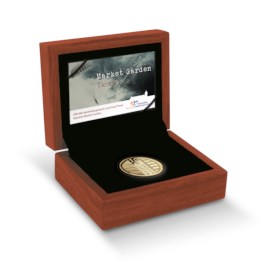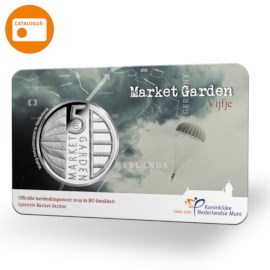
From the designer - Market Garden 5 Euro Coin
Tim Breukers about his design
“In 2019, it will be 75 years since Operation Market Garden took place. It was the largest military operation in the Netherlands during the Second World War. Ed van Seters, Chairman of the Military History Platform Ede, took me on a private tour to the dropping and landing zones. He told me, on the spot, about what happened so many years ago. His knowledge and enthusiasm made the history and the landscape come to life, it became tangible. In Airborne Museum Hartenstein my attention was drawn to the embroidered badges and emblems. I saw a playing field in the symbolism, materiality and complexity of those badges and emblems to design a coin for Market Garden."
Material
"Material plays a leading role in my visual work. For example, when clay deforms, cracks or breaks, it’s not always because I want it, but because the clay seems to want it. For me, working with a material feels like a collaboration with the material; I want to give it its own voice and let it speak. In the spirit of the badges, I worked with great pleasure on a design on the embroidery machine."
Embroidery stitches
"The satin stitch in the parachute brings different directions to the levels, which alternately reflect the light when the coin is tilted. The zigzag stitch will also make the light reflect, but through a transverse line that follows the forms of the bridge and the coin value. Both the zigzag stitch and the satin stitch create a subtle curve that gives the coin three-dimensionality and shape. The step stitch which fills the portrait of King Willem-Alexander on the front, shows a very different characteristic embroidery texture and structure. The sensitivity of a single wire can be traced in the text on the front and back. The "holes" where the threads come from can be simulated with an outline, it looks like it’s embroidered directly in the polished fond."
Badges
"The badges were carried by the various army units as identification marks. A badge ensures that the mutual bond is strengthened. A badge testifies to involvement with a group and involvement with an event. I have used the same kind of clear visual language that is made up of a number of iconic elements."
"Material plays a leading role in my visual work. For example, when clay deforms, cracks or breaks, it’s not always because I want it, but because the clay seems to want it. For me, working with a material feels like a collaboration with the material; I want to give it its own voice and let it speak. In the spirit of the badges, I worked with great pleasure on a design on the embroidery machine."
Embroidery stitches
"The satin stitch in the parachute brings different directions to the levels, which alternately reflect the light when the coin is tilted. The zigzag stitch will also make the light reflect, but through a transverse line that follows the forms of the bridge and the coin value. Both the zigzag stitch and the satin stitch create a subtle curve that gives the coin three-dimensionality and shape. The step stitch which fills the portrait of King Willem-Alexander on the front, shows a very different characteristic embroidery texture and structure. The sensitivity of a single wire can be traced in the text on the front and back. The "holes" where the threads come from can be simulated with an outline, it looks like it’s embroidered directly in the polished fond."
Badges
"The badges were carried by the various army units as identification marks. A badge ensures that the mutual bond is strengthened. A badge testifies to involvement with a group and involvement with an event. I have used the same kind of clear visual language that is made up of a number of iconic elements."
The coin
"The parachute on the reverse of the coin depicts the largest airborne operation ever on Dutch territory. The plan of the Allies consisted of the airborne operation Market and the ground offensive Garden. British, Polish and American airborne troops would take important bridges over Dutch rivers, after which ground troops could quickly advance from Belgium to the IJsselmeer via these bridges.
Also featured on the reverse of the coin is the bridge over the Rhine near Arnhem, to give the partial failure of the operation its place on the coin. The Allies failed to capture the bridge over the Rhine near Arnhem, as a result of which a large part of the Netherlands was not liberated until after the Hunger Winter.
The execution of the coin comes very close to the design in terms of appearance. The story of Operation Market Garden is told in this design through the iconography and through the material, so Market Garden comes tangibly close. ”

Said the designer of the Market Garden commemorative coin, Tim Breukers. The Market Garden commemorative coin is available in various qualities.
See all qualities
"The parachute on the reverse of the coin depicts the largest airborne operation ever on Dutch territory. The plan of the Allies consisted of the airborne operation Market and the ground offensive Garden. British, Polish and American airborne troops would take important bridges over Dutch rivers, after which ground troops could quickly advance from Belgium to the IJsselmeer via these bridges.
Also featured on the reverse of the coin is the bridge over the Rhine near Arnhem, to give the partial failure of the operation its place on the coin. The Allies failed to capture the bridge over the Rhine near Arnhem, as a result of which a large part of the Netherlands was not liberated until after the Hunger Winter.
The execution of the coin comes very close to the design in terms of appearance. The story of Operation Market Garden is told in this design through the iconography and through the material, so Market Garden comes tangibly close. ”

Said the designer of the Market Garden commemorative coin, Tim Breukers. The Market Garden commemorative coin is available in various qualities.
Market Garden 5 Euro Coin
Market Garden 10 Euro Coin 2019 Gold Proof
Official Golden Ten euro coin in honour of Operation Market Garden.

Market Garden 5 Euro Coin BU quality in coincard
Brilliant Uncirculated (BU) coins are the first coins to be minted with a new coin stamp.

